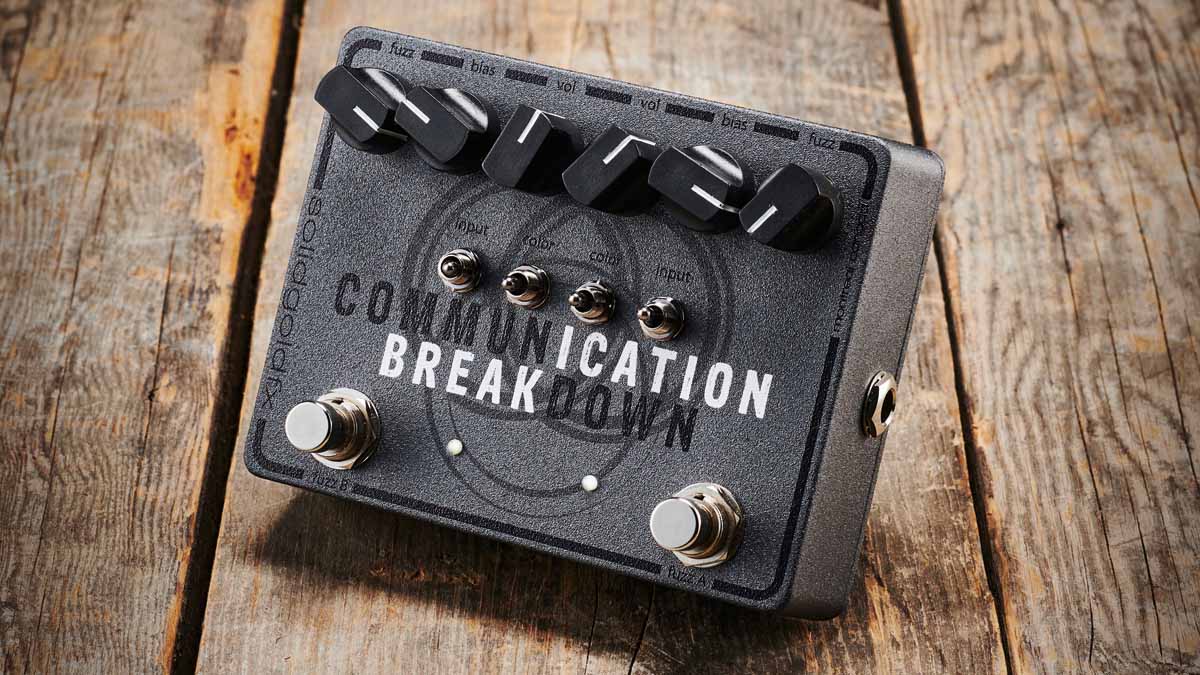MusicRadar Verdict
A two-in-one deluxe fuzz inspired by mid-60s Tone Bender circuits but updated for today's player, the Communication Breakdown is a lot of fun and very practical, too.
Pros
- +
Two fuzz classics in one pedal.
- +
Bias control allows you to dial in fat or gated fuzz.
- +
Color switch offers quick-fix EQ adjustment.
- +
Plays well with wah pedals.
Cons
- -
Knobs are a little cramped.
MusicRadar's got your back
What is it?
The name gives the game away with SolidGoldFX's Communication Breakdown. It's a dual fuzz pedal voiced for Jimmy Page Led Zeppelin tones, and it houses two takes on the Tone Bender circuit in one enclosure.
Each of the fuzzes has its own controls and a footswitch. They can be used individually or, when the occasion demands it, together, and while this might be a back-to-the-future design, reanimating old-school fuzz in a new-school format, this combination of fuzz textures can make for some far-out tones.
Fuzz A is based on a dual-transistor design of Tone Bender that was produced in 1966 between the MkI and MkII, a design that's less associated with Sola Sound units and more with the Italian-built Vox Tone benders. Fuzz B, meanwhile, is based on the MkII Tone Bender, and that's your circuit for that sinewy Jimmy Page tone.

But this is 2020, so we're not talking clones; this is more loving pastiche with a few improvements. For a start, you'll find Fuzz A to be a little hotter than its vintage forebears, and JFET preamp making Fuzz B a little more housetrained.
Both sides of the fuzz have the same control setup, with Fuzz, Bias and Volume knobs behaving just as you'd expect them to. Bias being the most significant in changing the character of the fuzz from open to choked.
There are switches for Color and Input, with Input switching input attenuation to accommodate a wah in the signal path, and Color a three-position toggle that lets you choose a flat EQ or two varying strengths of top-end roll-off and mid-scoop.
Under the hood there are internal DIP switches for either Fuzz, selecting a Bold mode for extra output and midrange width, and default Comp, which is a little more compressed and smoother.
Want all the hottest music and gear news, reviews, deals, features and more, direct to your inbox? Sign up here.
Performance and verdict
With the Color set neutral and input attenuation off, Fuzz A gives a very decent impression of a Fuzz Face. It has the vinegar-sharp treble presents itself as all chewy crunch and grit at lower settings and cleans up nicely when you roll your volume control back.
That brightness is ever-present but if you want to mellow it out the Color switch is your friend. That said, the Bias control is the most transformative fuzz-shaper on the menu. Some will love the splutter at one extreme, others the super-smooth openness at the other.
There is an abundance of cool staging posts en route to either, and perhaps most will find their sweet spot along the way.

If you are going straight into the pedal from your guitar, keep an eye on how you have the input attenuation set as it can cut gain and low end depending on how it is set. It's another EQ consideration. But if you play a wah before the fuzz the input attenuation is a life-saver, letting your wah live its life to its fullest.

• Z.Vex Fuzz Factory
Yes, it can be a beast that needs taming, but it offers probably the widest variety of fuzz-derived sounds in a single pedal.
• Wampler Velvet Fuzz
We love a good fuzzbox, and the Velvet Fuzz is one of the most versatile we've heard lately: it will give you that vintage 60s thing, but also something that you may find more current, all cleaning up seamlessly with your volume knob.
Fuzz B is probably the easiest to use in service of those classic MkII tones. Just be careful how you touch that bias dial. It's compression helps it towards that velvet sustain. When you are of a mind to dig out the Mothership tab book – in other words, when Saturday comes around – Fuzz B has you covered.
Just don't see the name Communication Breakdown and think that that is all it does. Indeed, its setup inspires creative thinking, and being able to use both in unison opens up possibilities, such as using one as your baseline fuzz and the other as a boost for atom-splitting during the solo.
MusicRadar verdict: A two-in-one deluxe fuzz inspired by mid-60s Tone Bender circuits but updated for today's player, the Communication Breakdown is a lot of fun and very practical, too.
Hands-on demos
Guitarist Magazine
Andy Demos
R.J. Ronquillo
SpiralCasterPlaysPedals
Specifications
- ORIGIN: Canada
- TYPE: Fuzz pedal
- FEATURES: True bypass
- CONTROLS: Fuzz x2, Bias x2, Volume x2 , Input switch x2, Color switch x2, Fuzz A footswitch, Fuzz B footswitch, internal dip switches x2
- CONNECTIONS: Standard input, standard output
- POWER: 9V DC adaptor 10mA
- DIMENSIONS: 123 (w) x 94 (d) x 52mm (h)
- CONTACT: SolidGoldFX
MusicRadar is the number one website for music-makers of all kinds, be they guitarists, drummers, keyboard players, DJs or producers...
- GEAR: We help musicians find the best gear with top-ranking gear round-ups and high-quality, authoritative reviews by a wide team of highly experienced experts.
- TIPS: We also provide tuition, from bite-sized tips to advanced work-outs and guidance from recognised musicians and stars.
- STARS: We talk to musicians and stars about their creative processes, and the nuts and bolts of their gear and technique. We give fans an insight into the craft of music-making that no other music website can.

